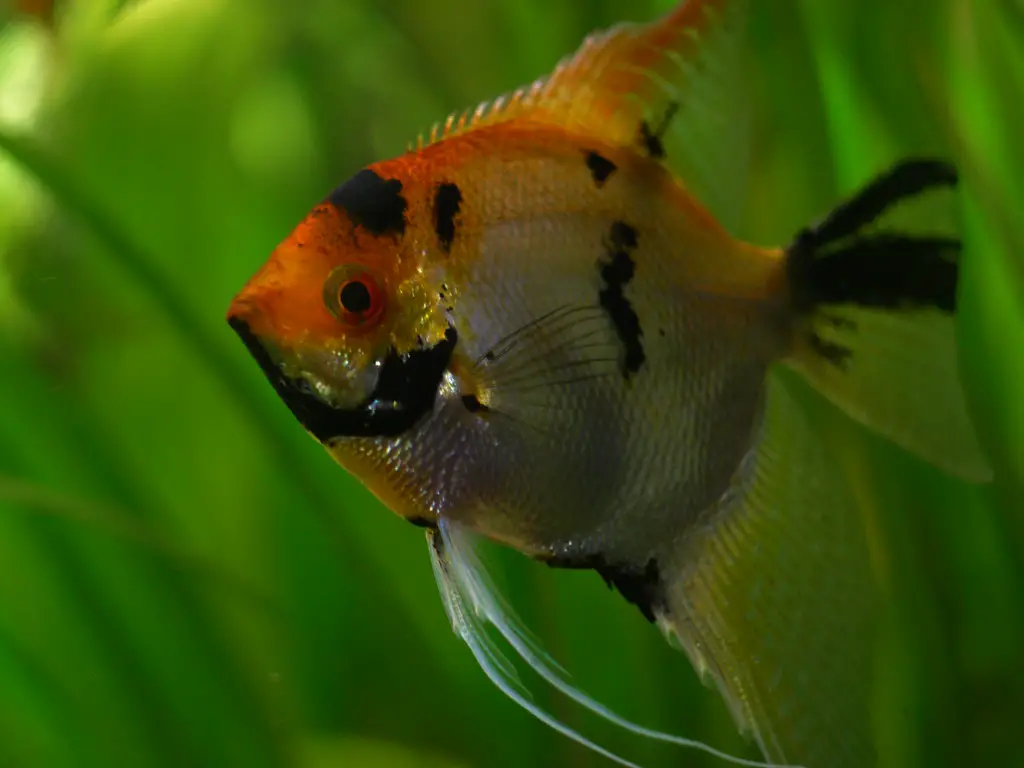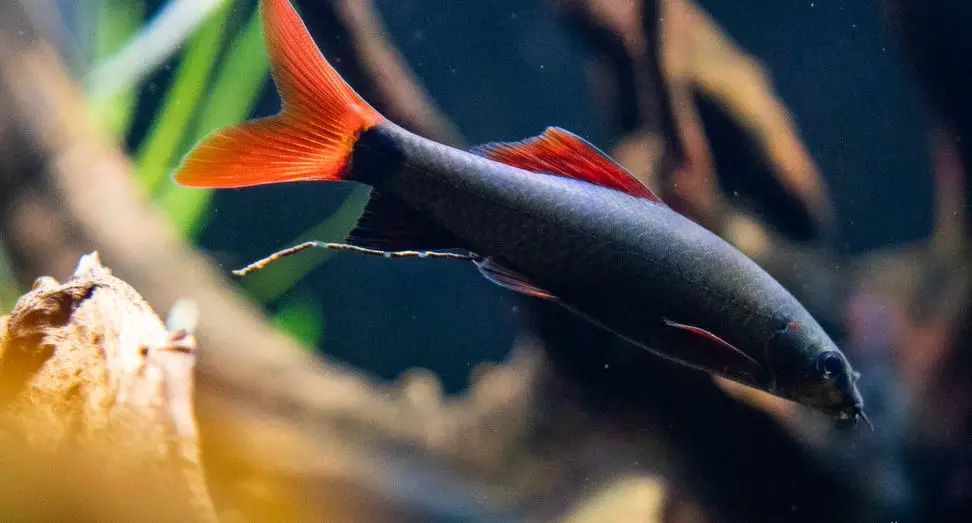Imagine you find yourself inside a cabin in the middle of a dense jungle. Certainly, you would not feel comfortable coming out, right? You will have insecurity, anxiety, and fear of the unknown and probable life-threatening dangers. Now again, imagine you have neighbors that live in the nearby surrounding. The presence of others certainly bring more sense of security and comfort, isn’t it? Similarly, fish in an aquarium, even though lacking humane feelings, have extremely observant attributes, due to which they tend to be intimidated and hide from other fish they consider a threat. This is where the role of Dither Fish in reducing anxiety and nervousness of other fish comes to play.
Dither Fish are the random, bold, and valiant aquarium schooling fish that swim around in the tank freely. Furthermore, they encourage and comfort the nervous, intimidated, and shy fish to come out of hiding and even help to reduce the aggression of some fish.
In this article, I will be talking about Dither fish, along with the various types of Dither fish according to their different sizes. So, stay tuned.
Why Should You Use Dither Fish In Aquarium?
Fish have been farmed and kept by us humans since ancient times. They have been the source of our food and amusement for our convenience.
In the modern world, fishkeeping has gained new heights as more and more fishkeepers have been keeping and breeding fish passionately for display in tanks. But, the whole idea of displaying fish fails when your prize possession is always hiding in their hideouts, right?
So, here are some reasons why you should use dither fish in your aquarium.
Reduce Danger From Predators
Fish, in general, are constantly on the lookout for probable dangers in their surrounding. Because, in the wild, survival from predators and unknown dangers is always the priority for any animal.
Similarly, even in an enclosed environment like an aquarium, there are potential predatory dangers for fish from other fish. Due to this, some of the fish are always on edge and tend to hide, making the aquarium look less lively. Many of the fishkeepers use Dither fish to solve this problem.
Reduce Anxiety, Nervousness And Stress
Dither Fish can be any arbitrary group of schooling fish used to reduce intimidation, anxiety, the nervousness of other fellow fish in the aquarium.
In simple words, these fish tell other fish that there is no danger here, and it is okay to come out in the open. They are, in a sense, comforter or watchdogs of other shy and nervous fish.
Make Your Aquarium Look Lively
When the nervous fish observe a school of Dither fish swimming freely in the tank, they too are motivated to come out of their hiding. As a result, your aquarium will look more lively and beautiful.
How To Choose The Right Dither Fish?
The selection of the right Dither fish for your aquarium is easy. While choosing the dither fish for your aquarium, you should look out for the following facts:
Nature Of The Fish
Dither fish should be peaceful and non-aggressive in nature. Due to these traits, they are able to make the shy and intimidated fish more alive and active in the aquarium. Hence, while choosing the fish as Dither fish, one of the most important things you have to ensure is their tranquil and pacifist nature.
Compatibility With The Fellow Fish
While choosing the Dither fish, you should have enough knowledge about the fish that you already have in your aquarium. Furthermore, aggressive or predatory fish are not compatible with peaceful dither fish. Due to this, compatibility is a major factor while choosing the dither fish.
Size Of Tank Mates
There are different Dither fish of different sizes, from tiny to large sizes. I recommend you to choose larger Dither fish for larger tankmates and smaller dither fish for small-sized tank mates. There is a probability of larger fish tend to prey on smaller fish. For example, the Tinfoil Barbs can prey on smaller fish.
You might also be interested in Small Tropical Fish That Does Not Require Much Space.
Similar Parameters
Different fish need different levels of parameters in their surroundings. The pH levels, temperatures, and the hardness of water all need to be supervised and maintained for their health and survival.
Due to this, while choosing particular species of fish as Dither fish in your tank, you should ensure both the fish in your tank and Dither fish have a similar requirement of water parameters and conditioning.
You might also be interested in How to Increase pH Levels in a Freshwater Tank and How to Maintain Aquarium Water Hardness.
What Are The Best Species Of Dither Fish?
As mentioned already, Dither fish are of different types depending on their sizes. From the tiny ones to medium and even larger ones, you can choose according to the size of their tank mates and the tank itself.
Below are some of the best species you can keep as Dither fish in the aquariums. Furthermore, I have classified the below Dither fish according to small size, middle size, and large size.
Dither Fish For Small Fish
The following are the small-sized Dither Fish:
Neon Tetras
Neon Tetras (Paracheirodon Innesi) are freshwater schooling fish from the Amazon basin of South America of the Characin family. These fish do great in a brackish water setup. As for schooling, a school of 6 Neon Tetras or more is recommended to be kept together in a school.
Moreover, they can withstand most dynamic water parameters, due to which they are considered hardy fish. In addition, you will find them very active in the tank, But with a sense of calmness. They are better Dither fish for Dwarf Cichlids, Paradise Fish, and Betta fish, etc.
Below is the specific requirement of Neon Tetras:
- Size: 1.2 to 1.5 inches
- pH: 4.0 to 7.5
- dKH: 1.0 and 12.0
- Temp: 68 to 82 °F
- Temperament: Peaceful fish
- Swimming: Middle level to top-level
If you are interested, you can check my article about Neon Tetra Fish Care Sheet.
Guppies
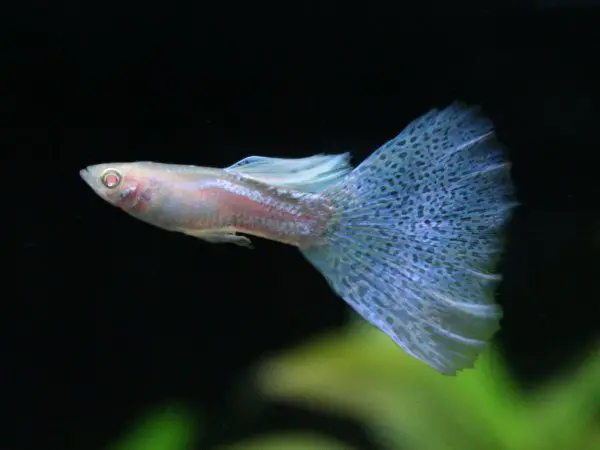
The Guppies (Poecilia Reticulata) are one of the most common names in the world of fishkeeping. Guppies are livebearer fish that make a great Dither fish. They are peaceful, easy feeders, and hardy, meaning they can adapt to a range of water parameters. Due to this, they are a joy to keep. In addition, they are very easy to breed and are in the heat most of the time.
Furthermore, there are wide ranges of guppies of different types, so there is a lot of choices to choose from. They are active fish, where the males will compete for the females.
Most of the fry from the breeding needs hiding shelter to survive, so you should consider separating the pregnant female when in time of the birth. For a school of guppies, you can keep about 8 to 10 guppies in a school, try to balance male and females while keeping them.
The following are the specific requirement of Guppies:
- Size: 1.2 to 2.4 inches (females) and 0.6–1.4 inches
- pH: 5.0 to 7.8
- dKH: 8.0 and 30.0
- Temp: 72° to 78°F
- Temperament: Peaceful fish
- Swimming: Lower level to middle level
Also Read:
Black Neon Tetras
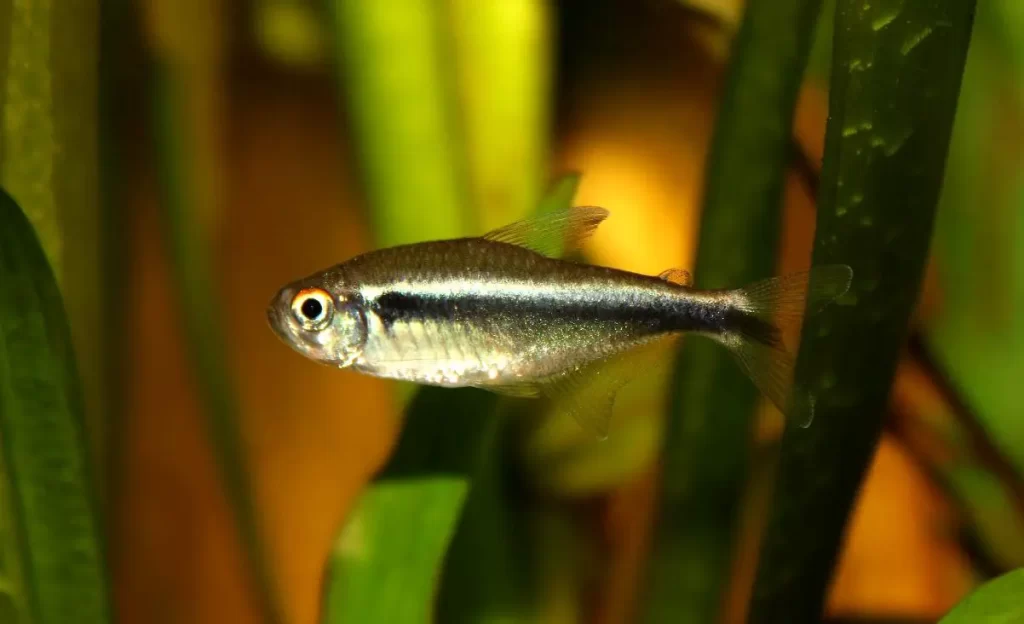
Black Neon Tetras (Hyphessobrycon Herbertaxelrodi), like their kin Neon Tetras, are from the Characin family but are native of the Paraguay basin of Southern Brazil. They do best in a school of 8 to 10.
I consider them a better version of Neon Tetras because they have all the good traits of Neon Tetras like hardiness, peaceful demeanor, and calmness without the common health problems of the Neons.
Below are the specific requirements of the Black Neon Tetras:
- Size:1.5 inches
- pH: 5.5 to 7.5
- dKH: 4.0 and 9.0
- Temp: 73 to 81 °F
- Temperament: Peaceful fish
- Swimming: Top level
Zebrafish
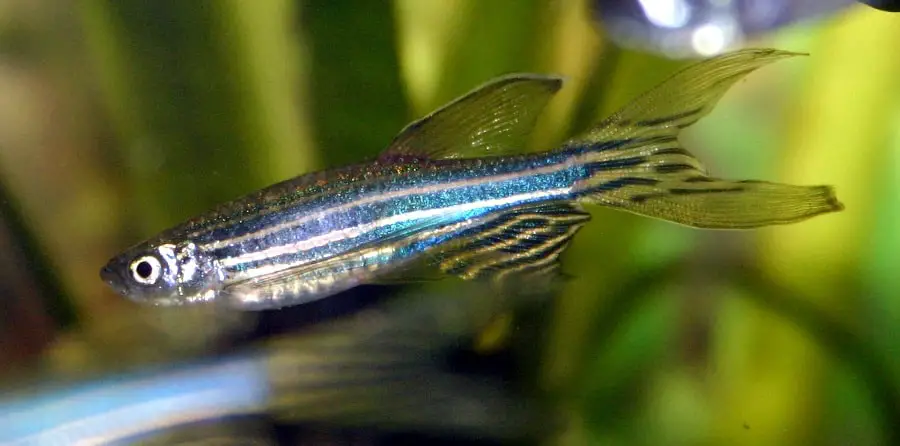
Zebrafish (Danio Reriro) are Cyprinids fish from the Carp family-like Goldfish and Koi fish. They are from Southeast Asia but are bred by the fish keepers on a worldwide basis. Zebrafish are a peaceful breed of fish and get along with any type of non-predatory fish.
Furthermore, these fish are very easy going when it comes to food and will accept anything you give to them. Zebrafish are easily adaptive to cold temperatures. Hence they can be kept in unheated aquarium tanks. And besides, They are very easy to breed too. Moreover, These fish are middle and top-level aquarium dwellers so, they make an ideal Dither fish.
The following are the specific requirement of Zebrafish:
- Size: 1.0 to 2.0 inches
- pH: 0.0 to 7.5
- dKH: 3.0 and 8.0
- Temp: 70° to 90°F
- Temperament: Peaceful fish
- Swimming: Middle level to Top level
Furthermore, to get more insight, you might want to read my article about Danio Fish: Types, Behavior and Care Routine
Norman’s Lampeye Killifish
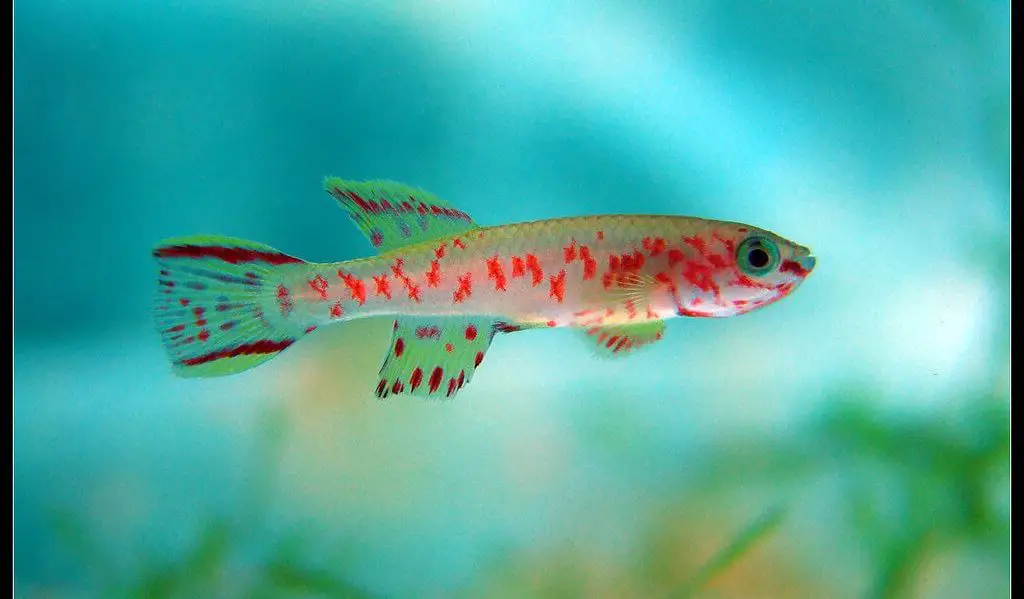
Norman’s Lampeye Killifish (Poropanchax Normani), also known as Norami Killifish, are from the Poeciliidae family. These fish are a special type of Killifish because they live longer than a year. Due to this, these fish are also known as annual killifish. I suggest you put these guys together in a school of 9. They are peaceful fish and get along with others.
The following are the specific requirement of Norman’s Lampeye Killifish:
- Size: 1.6 inches
- pH: 6.0 to 7.0
- dKH: 4 and 15
- Temp: 73° to 78° F
- Temperament: Peaceful and active fish
- Swimming: Middle level to Top level
If you are interested in knowing about Killifish in general, then check out the article about A Complete Beginner Guide to Killifish: Care, Breeding, Lifespan, Diet.
Banded Panchax
Banded Panchax (Epiplatys Annulatus) or also known as Clown Killifish and Rocket Killis, are schooling fish from the Southern Guineas. I recommend keeping them in the numbers of 8 or 10 in a school. These fish are very friendly and social to others, making them a good choice as Dithers.
In addition, banded Panchax likes to live in slow-moving acidic, soft, and warm waters. So, you should put a sponge filter, which will provide the vibes of slow-moving water. I would suggest these two sponge filters for your aquarium:
The following are the specific needs of the Banded Panchax:
- Size: 1.3 inches
- pH: around 6.0
- dKH: 6.6 and 7.6
- Temp: 750 to 800 F
- Temperament: Peaceful fish
- Swimming: Top level
Dither Fish For Medium Sized Fish
The following are the Medium-sized Dither fish:
Harlequin Rasbora
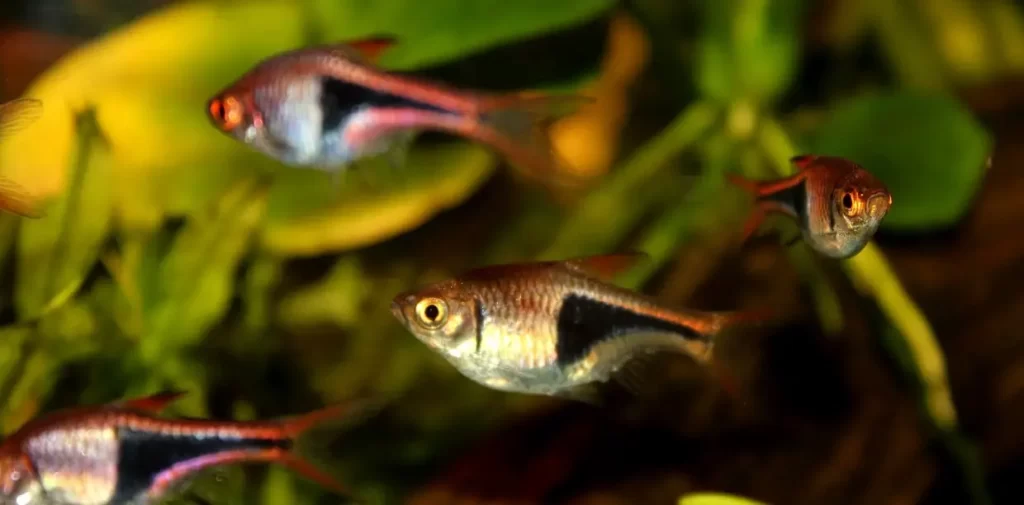
Harlequin Rasbora (Trigonostigma Heteromorpha) are species of shoaling fish that stay peaceful and calm when in the company of their species. In addition, they like to stay in a group of 6 to 10 in a surrounding where there is a lot of plants.
You might also like our other article about 9 Best Low Light Aquarium Plants | Benefits of Aquarium Plants.
The following are the specific needs of the Harlequin Rasbora:
- Size: 2.0 inches
- pH: 6.0 to 7.5
- dKH: 5.0 and 7.0
- Temp: 72 °F to 81 °F
- Temperament: Peaceful fish
- Swimming: Middle level
Moreover, you can read my article about the Harlequin Rasbora Care Sheet: Lifespan, Breeding, Tankmates, Diet
Boesemani Rainbow Fish
Boesemani Rainbow Fish (Melanotaenia Boesemani) is one of the attractive fish from the Melanotaeniidae family and is found in Madagascar, Indonesia, and Australia. I have to say, looking at their beauty and grandeur, these fish are very underrated fish in the world of fish keeping.
Moreover, the males are more colorful and beautiful than the females, as well as a fin extension, which the females lack. Especially, Celebes Rainbowfish are great Dither fish for the smaller community aquariums.
These fish are carnivores, so feed them with brine shrimps and blood worms, which will help them to gain even brighter colors. In the case of water conditions, they are able to adapt to a large range of water parameters.
The best brands out there are Ocean Nutrition Instant Baby Brine Shrimp 0.7-Ounces (20 Grams) JarBrine shrimp for brine shrimps and SAN FRANCISCO BAY Brand Freeze Dried Bloodworms 1.75oz for bloodworms.
The following are the specific requirements of Rainbow Fish:
- Size: 2.4 to 4.7 inches
- pH: 7.0 to 8.0
- dKH: 5.0 and 20
- Temp: 74° to 78° F
- Temperament: Non-Aggressive fish
- Swimming: Top level
Tiger Barbs
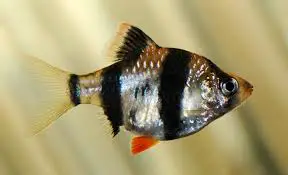
Tiger Barbs (Puntigrus Barbus) are schooling fish with fast movement. They are from the Cyprinids family and originate from Southeast Asia. My favorites are the Tiger Barbs. They are bulky in size and have the attracted silvery yellow color with black stripes. Furthermore, these fish are ideal for medium-sized fish as Dither fish.
In addition, you have to ensure at least a 20-gallon tank if you want to keep these fish. As barbs are usually bulky and active, they need sufficient space to move around.
I suggest you try Tetra Aquarium 20 Gallon Fish Tank Kit, Includes LED Lighting and Decor for an aquarium.
The following are the specific requirements of Tiger Barbs:
- Size: 1.0 to 6.0 inches
- pH: 7.0 to 8.0
- dKH: 5.0 and 20
- Temp: 74° to 78° F
- Temperament: Non-Aggressive fish
- Swimming: Top level
Fire Tetra
Fire Tetra (Hyphessobrycon Amandae), also known as Amber Tetra, are hardy and playful schooling fish from the blackwater of South America. Moreover, they like an open space due to activeness and enjoy some plants in their surrounding. I recommend you keep a school of 8 Fire tetras together.
The following are the specific requirements of Fire Tetra:
- Size: 3.0 to 4.0 inches
- pH: 5.5 to 7.0
- dKH: 1.0 and 10.0
- Temp: 74° to 78° F
- Temperament: Peaceful fish
- Swimming: Middle level to top-level
Leopard Danio

Leopard Danio (Brachydanio Froskei), as we can imagine from their name, are eccentric fish with black spots on a silvery yellow background body color. These fish are from the Cypriniformes family and are found in South Asia.
Furthermore, these fish have been a favorite among freshwater fishkeepers for a long time. You can keep a group of 6 or more Leopard Danio in a school. But, make sure you provide them enough space as they like to swim around more often.
The following are the specific requirements of Leopard Danio:
- Size: 1.4 to 2.0 inches
- pH: 6.6 to 8.0
- dKH: 2.0 and 20.0
- Temp: 64 to 75° F
- Temperament: Peaceful and friendly fish
- Swimming: Middle level to top-level
Also, Read Longfin Leopard Danios: Everything You Need To Know
Silver Dollars
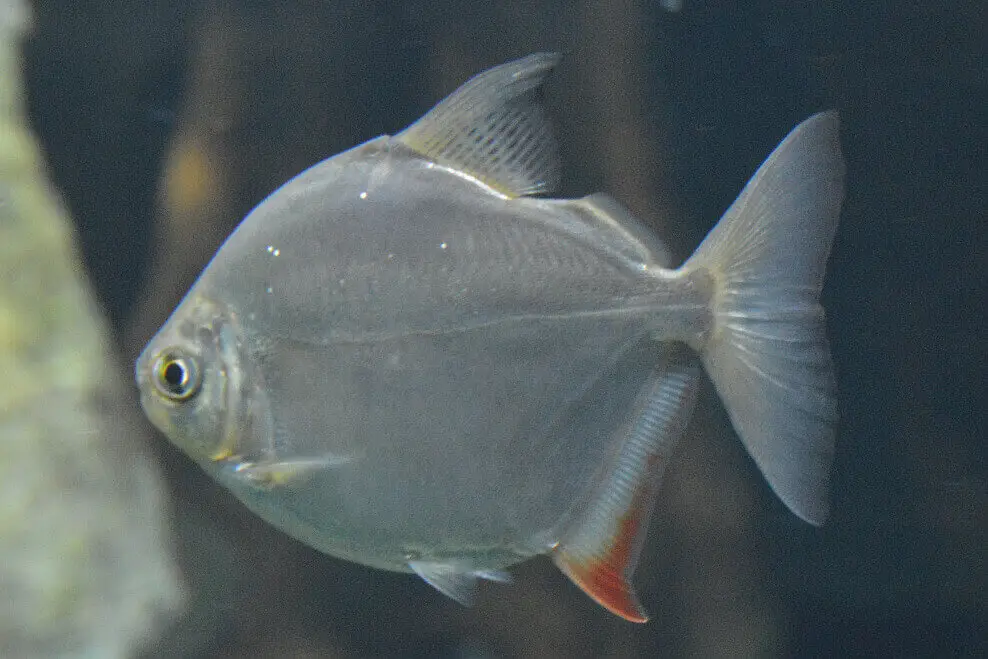
Silver Dollars (Metynnis Argenteus) are from the Serrasalmidae family like the Pacu fish. In the wild, they form a school of 100 or more. They are hardy fish and prefer acidic waters but, a little alkaline water does not hurt them at all.
These fish are vegetarians and feed on the aquatic plants in the wild. Whereas, in tanks, Silver Dollars will appreciate flakes and pellets. But, you should also give blanched vegetables like spinach and cauliflower.
Furthermore, these fish are peaceful and friendly with their tank mates and are good Dither fish. As they are slightly bigger fish, they should not be kept in an aquarium smaller than 125 gallons to evict any potential chasing. In addition, they might eat the planted live plants in the tank if you plant any in the tank.
The following are the specific requirements of Silver Dollars:
- Size: 6.0 to 8.0 inches
- pH: 0.0 to 7.0
- dKH: 2.0 and 20.0
- Temp: 64 to 75° F
- Temperament: Peaceful and friendly fish
- Swimming: Middle level
Pencilfish
Pencilfish (Nannostomus) are freshwater fish belonging to the Lebiasinidae family and are a joy to keep. They are Mainly found in the Rio Negro, and the Amazon River. Moreover, they have often been considered a substitute for Tetras due to their activeness and schooling. In addition, Pencilfish are jumpers, so an aquarium lid is compulsory for them.
Find out more on Why Do I Need A Lid For My Fish Tank? Here Are My 5 Reasons
Furthermore, these are schooling fish, so you should aim for at least 6 or more. They are hardy fish, so they can withstand most of the water parameters.
The following are the specific requirements of Pencilfish:
- Size: 2.0 inches
- pH: 5.0 to 7.0
- dKH: 4.0 and 12.0
- Temp: 74 to 82° F
- Temperament: Peaceful fish
- Swimming: Middle level to top-level
Giant Danios

Giant Danios (Devario Aequipinnatus) are tropical fish that belong to the Cyprinidae family. They are one of the perfect Dither fish for medium-sized aquariums. Having a peaceful nature, these tend to make great tank mates and get along with other fish.
Moreover, these danios are fast schooling fish, hence adding to their C.V of being a great Dither fish. I recommend keeping at least 6 in school. As they mature, they tend to go back and forth in the tank; hence, they need spacious space just enough according to their size.
The following are the specific requirements of Giant Danios:
- Size: 3.0 to 5.0 inches
- pH: 0.0 to 7.5
- dKH: 3.0 and 8.0
- Temp: 72 to 81 °F
- Temperament: Peaceful fish
- Swimming: Middle levels to the upper level
Dither Fish For Large Sized Fish
The following are the Large-sized Dither Fish:
Bala Shark
Bala Shark (Balantiocheilos Melanopterus) are freshwater fish from the Cyprinids family. Although, in name, they are called sharks, in reality, they are more related to the Barbs and Goldfish. Furthermore, they are native to Indonesia and eat plankton and small invertebrates in the wild. These fish are called gentle giants because they are not nippy.
Moreover, due to their size of an average 1 foot, Bala Sharks can slam into the aquarium, due to which they need a considerably large aquarium of about 180 gallons. In addition, they are to be kept in a school of 6 if kept alone they can be nervous.
The following are the specific requirements of Bala Shark:
- Size:10.0 to 14.0 inches
- pH: 6.0 to 7.0
- dKH: 2.0 to 10.0
- Temp: 64 to 75° F
- Temperament: Peaceful and friendly fish
- Swimming: Middle level to top-level
Pacu
Pacu (Colossoma Macropomum) is from the Serrasalmidae family like the Silver Dollars and Pirahna. In fact, they are the biggest of Serrasalmidae. Similarly, they are the biggest among all other considered Dither fish. Moreover, Pacus are found in subtropical South America are also caught and eaten by people in the real world.
Furthermore, Pacu has teeth that help them to feed on the fruits as well as leaves and water plants. Due to their sheer big size, Pacu needs a big aquarium of about 300 gallons. For schooling, you need to consider the size of the tank you are going to keep the fish in.
The following are the specific requirements of Pacu:
- Size: 24.0 to 36.0 inches
- pH: 6.0 to 7.5
- dKH: 2.0 and 15.0
- Temp: 75 to 80° F
- Temperament: Non-aggressive fish
- Swimming: Middle level
Tinfoil Barb
Tinfoil Barb (Barbonymus Schwanenfeldii) are from Southeast Asia and Northern Indonesia and belongs to the family of Cyprinidae. These fish are also used for food in their native area. Tinfoil barbs are the largest among other barbs and are schooling fish.
In addition, these fish are omnivores, due to which you need to maintain a balance of plant-based diet like blanched vegetables and flake vegetables. Although they make good Dither fish, they can prey on smaller fish. So, you should keep them with larger shy fish only.
The following are the specific requirements of Tinfoil Barbs:
- Size: 10.0 to 14.0 inches
- pH: 6.0 to 7.5
- dKH: 3 and 8
- Temp: 72 to 77 °F
- Temperament: Rarely aggressive fish
- Swimming: All levels
Frequently Asked Question
How Do Dither Fish Help Shy Fish?
Dither fish help shy fish by reducing their shyness, timidity, and aggression of other fish. Furthermore, they also help to promote normal social behavior in the other fish by providing them a sense of security.
Why Are My Fish So Shy?
It can be a rather surprise, but one of the main reasons for your fish’s shyness can be loneliness. The chances of loneliness being the reason increase even more if your fish are small. Because most of the fish live in schools in the wild and prefer to live in groups, even in the aquarium.
The school provides them a sense of security and even gives them the confidence to quit hiding. In general, the school provides them a sense of assurance of protection from any predatory dangers.
However, the solution to this problem is introducing Dither fish in your aquarium because they help the shy fish to overcome anxiety, shyness, and discomfort.
Conclusion
A large variety of fish, ranging from big fish to small fish, are kept as pets in exquisite tanks by the fish keepers. But, the problem occurs when the whole reason for keeping the fish for display in the tank is not met. Because some fish feel intimidation, shyness, or even fear of predation in the tank, due to this, they always tend to hide, making the aquarium seem fishless.
Similarly, in the wild, these types of fish prefer a community or school in the wild. They feel a sense of security and comfort in groups and schools, rather than being alone. As a result, we can see large schools and communities of fish in various aquatic habitats in the wild.
So following their natural behavior of preferring a safe school above being alone in the surrounding, some fish tend to hide rather than swimming in the tank environment.
As a solution, Dither fish play a vital role in making these shy fish comfortable by reducing their shyness and timidity and even reducing the aggression of the other fish. Hence, prompting the other fish to come out making your aquarium lively.
If you have any further inquiries regarding Dither fish, feel free to present them in the comments below.






